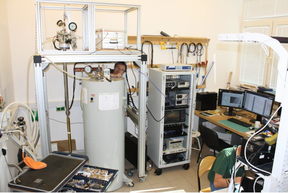AQP seminaari: Escape rate problem in driven Josephson junctions

Milloin
Missä
Tapahtuman kieli
Abstract:
Josephson effect in a superconductor-insulator-superconductor (SIS) junction is a macroscopic quantum tunneling phenomenon where Cooper pairs tunnel through an insulating barrier without any applied voltage [1, 2]. When a Josephson junction is operated in the zero-voltage state with a non-zero bias current (dc and ac) the phase difference between the macroscopic wavefunctions of two superconductors acts as a particle subject to a tilted-washboard potential. The phase particle stuck in this potential can escape via thermal exciton or it can tunnel quantum mechanically. At a very small temperature, the quantum tunneling process dominates [3, 4, 5].
I will present our theoretical study of the escape (tunneling) rate problem for the phase particle in the current biased Josephson junction (CBJJ). We have developed a simple and efficient quantum mechanical method for the static case (dc bias current) and calculate both the position and width of resonances which relate to the tunneling rates. Then we also add a radio-frequency harmonic driving term (ac bias current) [5,6] and derive via the Floquet formalism the corresponding tunneling rate out of the ground-state which shows a strong resonant enhancement when the drive frequency matches the excitation energy of the junction.
References:
[1] B. D. Josephson, Phys. Lett. 1 (7), 251–253 (1962)
[2] B. D. Josephson, Rev. Mod. Phys. 46 (2), 251–254 (1974)
[3] R. F. Voss, R. A. Webb, Phys. Rev. Lett. 47, 265 (1981)
[4] J. M. Martinis et al. Phys. Rev. Lett. 55, 1543 (1985)
[5] Christian Kraglund Andersen and Klaus Mølmer, Phys. Rev. A 87, 052119 (2013)
[6] Edward Goldobin et al. (Tubingen group), private communication
- Julkaistu:
- Päivitetty: